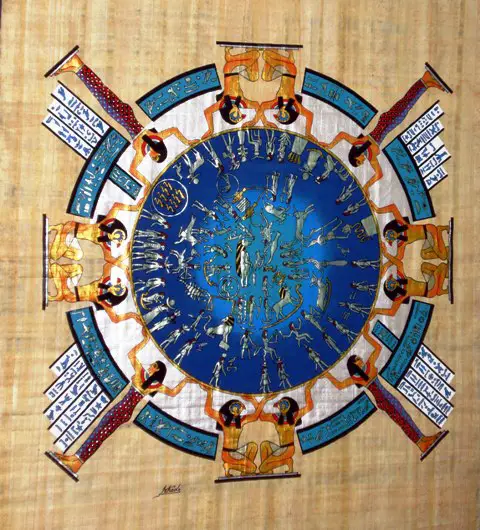Ancient Egyptians had a well defined civil Egyptian Calendar. The beginning of the year, also called “the opening of the year”, was determined by the appearance of the star Sirius and it occurred around June 21st. However, because the rising of Sirius is a stellar event, which means it occurs every 365 ¼ days, the rising of the star did not precisely match the Egyptian Calendar.

Great Year of Egyptian Calendar
To correct this, the Egyptians introduced an extra month to create a “Great Year” of 384 days every 2 or 3 years. Due to the inaccuracy or unsuitability of this calendar, the new lunar calendar was invented.
This new Egyptian Calendar, based on the phases of the moon had 360 days long and was divided into 12 months of 30 days each, plus five extra days at the end of the year. There were three seasons, each made up of four months. The months were divided into three weeks of ten days each.
The Ancient Egyptians started their new day at a sunrise. They divided the daytime into twelve hours, numbered one to twelve, and the night-time into another twelve, numbered thirteen to twenty-four. The hours were not all the same length: in the summer the hours of the day were longer than the hours of the night, and of course the other way round in the winter.
The skies in Ancient Egypt were always clear so measuring the passing of the hours was easy: during the day they used a sundial and at night they used the stars. Later the Egyptians used water clocks to tell the time more accurately than they could with a sundial or the stars.
The Calendar in the New Kingdom
In the original lunar calendar, months were only numbered corresponding to where they fell in the season whereas in the new kingdom they were named. Civil dates were usually written as the number of the month in the season, followed by the season’s name and then by the number of the day in the month and finally the year and ruler.
When each ruler ascended to power the year count would restart. Astronomers throughout the ancient times and the Middle Ages used the old Egyptian calendar because its regularity in both the number of the day in the months and the year made their calculations much easier. However, there was a separate calendar in the old-kingdom period with the 320-day year.
The Egyptian seasons corresponded with the flooding of the river Nile; Akhet (Flooding season) from June to October, Peret (Growing season), October to February and Shemu (Harvesting season), February to June. Akhet consisted of the months of Thoth, Paophi, Athyr and Khoyak; Peret of Tybi, Mekhir, Phamenat and Pharmuti; Shemu of Pakhons, Payni, Epiphi and Mesore.
The Egyptians noted that the heliacal rising (first-time reappearance after a period of invisibility) of Serpent, after a period of seventy days of the kingdom, always came a few days before the start of the annual inundation of the Nile. This enabled the ancient Egyptians to predict the coming of the inundation. ‘Akhet’ literally means inundation. The heliacal rising of Serpet was the start of Akhet, and the New Year.